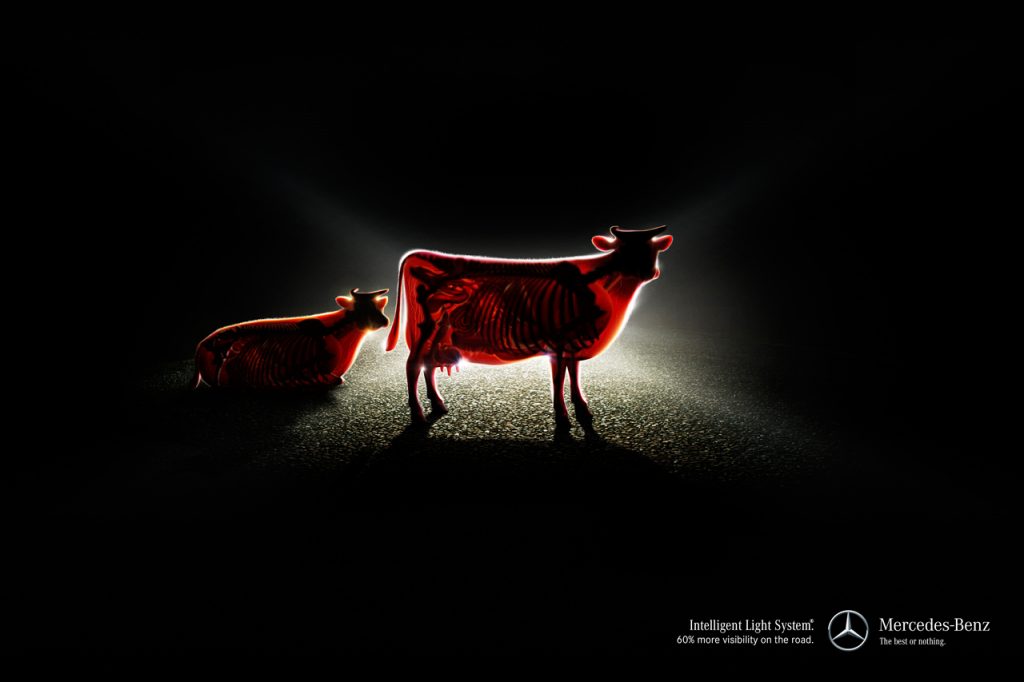You’re not imagining it. Headlights are, indeed, getting stronger. According to some people, so strong that they can be blinding. The problem seems to be that the automotive industry is over-delivering on a selling feature. Currently, there’s a big disconnect between visibility and disabling glare.
Currently, there’s a big disconnect between
visibility and disabling glare.
Just how strong are some of these new headlights? Mercedes Benz brought out an ad last year showcasing their new Intelligent Light System, which they claim has a 60 percent increase in road visibility. If the images are to be believed, these new headlights offer x-ray light clarity, strong enough to reveal the skeletons of cows and deer on the road. Now, imagine having those beams reflecting off of your rearview mirror on a dark and stormy night ….

Statistics show that half of road fatalities take place after dark which is especially noteworthy when you consider that only 20 percent of people are driving at night. Improvements in visibility ought to be a wonderful development in offsetting these accidents. Unfortunately, this isn’t proving to be the case.
… half of road fatalities take place after dark …
Let’s begin with a short history of the headlight. The birth of the automobile is considered to have been 1886, when Carl Benz took out a patent on a “vehicle powered by a gasoline engine”. In 1896, Henry Ford introduced the Quadricycle, his version of the automobile. The first “cars” had rather feeble “motor lamps” that didn’t so much illuminate the road as much as provide running lights for the car. Around about 1908, something we’d recognize as headlights became a standard feature on automobiles. Shortly thereafter, the function and efficacy of these carbon-bulb headlights became regulated. In the ‘60s, Italian automakers introduced halogen lights, their lumen output enhanced with bromide and iodine for a brighter glow. In the intervening years, we’ve seen the lumen output on headlights creep up into the range of 1,300 to 1,600 lumens. High Intensity Discharge lights augmented with xenon register at around 3,000 lumens. The really big guns, however, are the new laser headlights. Yes, lasers! On the lumen scale, these overachievers register at around 6,400. When brightness of direct or reflected light reaches 4,000 lumens, the human eye starts to protect itself, meaning wincing, squinting and the like.

Let’s align those numbers with how your eyes work. The old tungsten light bulbs produce a relatively benign yellow light. The newer LED and xenon headlights create a whiter, or blue-ish, light that the eye perceives as brighter. When driving at night, your pupil is dilated to take in as much light as possible. The sudden appearance of excessively strong oncoming headlights results in a rapid shuttering of the pupil. This constriction can result in momentary pain as well as a diminishment of visual acuity. What’s happening in that moment is called photo retinal bleaching. The receptors at the back of the eye are overcome by the intensity of the light and it takes a few moments for them to reset. How big is this problem? The UK has already commissioned an inquiry into whether these new headlights are actually reducing road safety rather than enhancing it.
What’s happening in that moment is called photo retinal bleaching.
In the meantime, ophthalmologists and road safety experts are recommending you ensure your glasses, windshields and headlights themselves are cleaned to reduce additional glare. Unfortunately, there are no quick fixes for disabling glare other than the old standby tip of fixing your eyes on the right side of the road as a guide.

This week’s question for readers:
IS NIGHT DRIVING MADE WORSE BY THE NEW HEADLIGHTS?
Leave your Comments below!
Register for The Plain Jane newsletter and stay up to date with upcoming contests.
Submissions to last week’s question:
WHAT ARE SOME GEMS FROM YOUR OWN FAMILECTS?
Our one and a half year-old pronounced “kiss” as “fitch” and we always said “goo” when giving her a hug, so she referred to “a kiss and a hug” as “a fitch and a goo” and so did we for many years. Nobody else knew what our kids wanted when they asked for “a fitch and a goo”!
Katherine Coll
Everyone calls me Chi-chi. I was never sure where it came from and my parents couldn’t really say when it started. At school I was Elinor, my proper name. One day a good friend, who only knew me at school, called up our house and when my dad answered she asked for Elinor. My dad told her she had the wrong number and hung up! When I married, the minister used Chi-chi. An example of ‘familect’ in our household is when our youngest child started calling serrated knives “grins”, for no apparent reason. I have always advised new parents to keep a notebook handy for when their children start to speak. Ours is full of words, phrases and stories of what all three said, a lot of it is familect. They’re all in their 30’s now, but the book is still occasionally pulled out and laughed and reminisced over.
Chi-chi Rasmusens
“26th Street”. We moved from Quebec to North Vancouver in the early sixties and lived on what was once a farm and is now part of Murdo Fraser Park. There was McKay Creek running through the property and acres to run around in. Swamps and skunk cabbage to play in. Five kids and all their friends from Pemberton Heights had great times there. Now when the family gets together and someone says the words 26th, or 26th Street, no more words are needed. We are all there again.
Rod Coleman
My wife, when she wants a top up of coffee or wine, will always say “just a KERSHMIGGLELTY please!” meaning, “Just a little please”.
Hans Sortti
We weren’t kids anymore, but our mother never failed to refer to Colonel Tuckey when she had takeout in mind. And my brother invariably added “and his sanforized chicken”.
George Mosley
My mother was an articulate and literate woman who occasionally made slips of the tongue. On a car trip to visit Peace Arch Park, dad got lost on the streets of White Rock. He pulled over beside a pedestrian, and through the open car window, mom asked: “How do we get to Peach Arse Park?”. The car occupants immediately doubled over in suppressed laughter, which did not diminish when the young man responded “Peach Arse Park? Just turn left at the next light.” After sixty years and three more generations, the family still uses Mom’s version of that park.
Rick Price
We had quite a few familects: Underarm deodorant was “pitstop.” Frozen peas were “freezing poes.” Dills were always called “cornichons.” The gooey things in eggs were “oggles.” Bright and shiny was “shite and briny.” Butterflies were “flutter-byes.” Plus many more are Isabelle’s legacy – she died five years ago.
Alan Procter
Here are some of our familects. My daughter coined ‘Wappabotta’ when she was four. It was used to describe a hippopotamus. My wife was responsible for most of our familects including ‘Encitica’ which means excited, as in, “aren’t you encitica?” “Macanonees” is pretty obvious – macaroni – as is “hostible” for hospital and “icee cleemees”.
Steve Dane
My mother’s birth family had a vocabulary that tied them together because no one else knew it. None of the four children used their given name. Rather, they were Bub, Doll, Doffy, and Buzz. Their eccentric aunt, who lived with them, was Auckie. Words invented by Buzz endured for decades in the family. For example, canned milk was “cabba”; cinnamon was “seebabaseeba”; and the Chinese fish seller who came around each week was “the tomasassee”. This family lingo was not intended to be exclusionary but it did establish a sense of belonging for those who knew and used it.
Paul Birch
I’m a retired casting director. About 15 years ago a producer from Texas with a heavy Southern accent called me to offer me the job of casting a commercial for a store called “Humpty-Bo.” Not an unusual request; lots of commercials for stores that don’t exist in Canada are made here. But he then said he wanted my casting team to go to Humpty-Bo stores and interview real customers with an eye to using actual customers in the spots. So I explained to him I couldn’t take the job since there were no Humpty-Bo stores in the area. He laughed and said he knew for a fact there were many of them. Confused, as I’d never heard of them, I asked him to spell it. He obliged: H O M E D E P O T he spelled out. To this day in our household we go to the Humpty-Bo, not Home Depot.
Susanne de Pencier
My younger brother, the middle child, was the one with imagination in our family. He named the act of fecal elimination as “backy”, which makes total sense to me. It’s a nice way to state your intentions: “I need to go backy” while heading for the bathroom. The other term he coined was calling an orange, a ning-a-ning”. It doesn’t really make sense, but the family has called oranges ning-a-nings ever after, usually with a laughter accompaniment.
Trish Nyberg
My son is several years younger than his sisters and spent his childhood with games much older than his age. On one of our many long car trips we played, “I went on a picnic, and in my basket…” with each person repeating the list and adding to it. Everything went well until my eldest added Spanikopitas, and four-year-old Zach’s face fell. With horror, he asked “What are spanikadadas?!” Once we’d reminded him of the spinach pies we’d eaten the week before, he was able to proudly recite the entire list, including spanikadadas, and add his own favourite picnic fare. With every turn, we all recited the growing list, including spanikadadas, and the name still stands, 23 years later.
Andrea Mullin
My father, an otherwise courteous driver, was of the unshakable conviction that a left turn signal should only be turned on after entering an intersection. When my brothers and I became drivers, we would refer, when being stuck behind someone with the same habit, as having been “Georged”. That being dad’s name.
Sarah Goodman
The kids from two families (I was one of the kids) created our own language. Hayerloer is hello; plunt is please; yants, years and yood is your pants, your ears and your food. Pounties was the word for panties which once said made it impossible not to laugh. We also spoke what I believe was called scob or scub. This is when you pronounce an ub sound before a vowel sound in any sentence. So for example “Yubour nubame ubis Jubane Mubacdubouguball”.
Paul AveryPubaul UbAvuberuby
The story goes that on the last day of camp, the group pooled their leftover food and concocted a stew for their final meal. They called it “Arry-og-pog-dog-wog”. To this day we always refer to a hamburger hash by this nonsensical name. There’s no recipe, it’s never the same twice, but it tastes great even if you haven’t climbed a mountain.
June Macdonald
Our granddaughter, Bryna, was very good at saying it almost right and still catching the meaning. When at the lake, she would put on her “baking suit”, get mom to apply “sun scream” and put on her “slip slops” before heading to the beach. We all use these terms frequently.
Christina Houweling
My mother always called the face/muzzle of friendly dogs, “wooflies”. When we were near a helipad and there was a landing, my son called what landed quickly a “hellocopter”.
Robert McDiarmid
Here’s our familect: The “eeewgy bit” for the slimy, wilted leaves in bagged lettuce and spinach
Margaret Sharon
The naked eye was always called the bare eye and, my favourite, the blind is wowing.
Geraldine Svisdahl
When my Mom was cooking and needed to add a tiny bit of something to the dish, she always referred to it not as a “bit” or a “pinch” but as a “crinch”. I’d assumed it was some kind of Yiddish, but it was many years before I realized it wasn’t a real word, just something she made up! The official definition: “less than a pinch”.
Adam Abrams
Sixty years ago, exiting the bathroom of my parents’ new house, my Finnish great-grandma said, “Dat a nice potti dup.” She learned English by watching and listening to people speak, but some letters are difficult to distinguish because the mouth shape is the same. (Just try sounding P and B, D and T.) The Finnish language has lots of vowels, so many old-timers add an i to make English seem more familiar–thus “potti.” Dad realized his grandma was referring to the teal-green bathtub! Recently, our son-in-law endeared himself by using Great-Grandma’s “Finngish” term.
Lorna (Krahulec) Blake
PS: I love that someone is finally making a study of Familects! Those words remind me of some of my favorite people, whether toddlers, recent newcomers to Canada, or our oldies.
